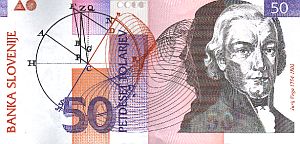Prologue
As far as I could judge by what I've seen on TV and in the papers, Slovenia seemed to be a rather untypical place among the ex-Yugoslav countries. Indeed - a comparison with Croatia, Serbia, Bosnia, not to mention Macedonia, is not easy. Slovenia is a small but fine country with great landscapes and few adventures for the travelers. Nevertheless, a coincidental encounter with some hostile Neo-Fascists in the capital has left a bitter aftertaste.
Visa
Most nationalities do not require a visa. A valid passport is all you need.
Money
The Slovenian currency was called Tolar - the similarity to the word "Dollar" is no coincidence, both words derive from the old German word 'Thaler'.

| ||
| Slovenian 50 Tolar banknote: Was worth € 0.2! |
The internationally common short form is SIT. One Tolar consisted of 100 Stotin,
but due to the high exchange rate the Stotin had virtually vanished long before. Coins come in 1, 5 and 10 SIT denominations and were not often used. There were plenty of colourful banknotes, with some of them being almost worthless - 10, 20, 50, 100, 200, 500, 1000, 5000 and 10,000 SIT banknotes are used. The inflation rate is very low, and Slovenia is about to join the European Currency Union within the next years. The average exchange rate as of
2004 is € 1 = 240 SIT.
Attention: In 2007, Slovenia had finally introduced the Euro - the Tolar is not in use any longer!.
There are ATM's everywhere, accepting all common credit cards as well as maestro and cirrus cards. The regular fee per transaction is € 4. Most banks can change cash.
Costs
Slovenia is probably the most expensive destination in Ex-Yugoslavia - it's slightly more expensive than →Croatia and substantially more expensive than →Serbia, →Bosnia and →Macedonia. However, the gap between prices in the capital and places outside the capital is much smaller than in other countries. Accommodation starts at around € 15 per night and person. Transportation is still rather cheap - the fare for the bus from the capital to the coast is around € 9. Eating out is cheaper than in let's say Italy or Germany. It's possible to get by on around € 40, depending on the level of activity and the hotel.
Getting there
By bus, train plane and in summer even by boat. There are several direct flights from various destinations in Europe, most of them landing in Ljubljana.
There are plenty of international train connections (especially to and from →Ljubljana): There's a direct express train from Munich, leaving at around 7 am and arriving in Ljubljana at 1 pm. The train to Munich is a night train, leaving Ljubljana at around 11:30 pm and arriving in Munich at 6:30 in the morning. A single ticket without discount costs € 60. When traveling from Germany, the so-called Slowenien-Sparticket is a good bargain. There's a 25% discount on return tickets - no matter where in Germany you're starting from - and even a 50% discount for fellow travelers. Austria offers something similar.
There are also direct trains to and from →Budapest. The ride takes around 8¾ hours, the fare for the return ticket is 11,445 HUF (€ 45). Funny enough, the single ticket is more expensive! The same express train continues to Venice (4 hrs). If you want to go to →Trieste (Italy), you will probably have to take the bus - there's only one train a day. It takes around 3 hrs. Most buses run via Koper. Sometimes it's necessary to change buses there (the overall fare is around € 16). Furthermore, there is a direct train to Thessaloniki (Greece, 25 hrs) via →Skopje and →Belgrade (9 hrs). There are more daily trains to the latter. There are also some direct trains to Vienna (6¼ hrs), Feldkirch (10 hrs) as well as to Innsbruck, Villach, Klagenfurt etc. Numerous local and express trains connect Ljubljana with the Croatian capital →Zagreb, which takes around 2¼ hours.
In summer, a ferry, to be more exactly a catamaran, crosses the Adriatic Sea from Izalo in Slovenia to Venice. It's a very expensive pleasure, but it takes 2½ hours only.
Border crossings
There are numerous border crossings to →Croatia, →Hungary, Austria and Italy. Most nationalities do not require a visa for the neighbouring countries. On the train, you won't even notice that you've just crossed the border.
Food and drinks
Slovenian restaurants usually offer an interesting blend of several European cuisines. German, Austrian, Hungarian, Italian and the typical Balkan cuisine heavily influenced Slovenia. Hence, eating out in Slovenia is definitely not boring. Most restaurants offer good service and high quality food. As in Dalmatia, seafood is quite common in the western part and definitely worth a try.
Slovenia produces very passable wine. Furthermore, typical Balkan and Hungarian firewater is very popular, too. Beer-lovers should definitely try Union Pivo from Ljubljana - it's an excellent lager!
©2024 Europe-East.com

 Albania
Albania Slovenia
Slovenia